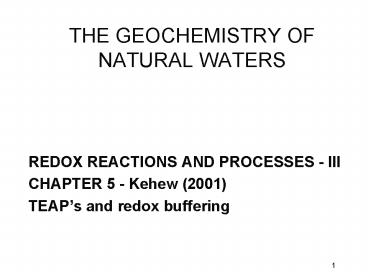THE GEOCHEMISTRY OF NATURAL WATERS PowerPoint PPT Presentation
1 / 9
Title: THE GEOCHEMISTRY OF NATURAL WATERS
1
THE GEOCHEMISTRY OF NATURAL WATERS
- REDOX REACTIONS AND PROCESSES - III
- CHAPTER 5 - Kehew (2001)
- TEAPs and redox buffering
2
LEARNING OBJECTIVES
- Learn a few more details regarding pe-pH (Eh-pH)
diagrams. - Discuss redox conditions in natural waters.
- Define and learn how to identify TEAPs.
- Learn the concept of redox buffering.
3
IDENTIFICATION OF TEAPs
- TEAP (Terminal Electron Accepting Process) - the
final redox reaction occurring in a natural
water. - We could in theory identify the TEAP by measuring
concentrations of electron acceptors and
metabolic byproducts. - Complications in nature make it more difficult to
use the above approach. - Different TEAPs give rise to different H2
concentrations, so measurement of H2 can help
identify the TEAP.
4
HYDROGEN CONCENTRATIONS FOR DIFFERENT TEAPs
- Methane production 5-10 nmoles L-1.
- Sulfate reduction 1-2 nmoles L-1.
- Ferric iron reduction 0.2-0.5 nmoles L-1.
- Nitrate or Mn(IV) reduction lt0.1 nmoles L-1.
- The drawback to using H2 concentrations to
identify TEAPs is that this requires measurements
to be made in the field using a specially
equipped gas chromatograph.
5
REDOX BUFFERING
The sequence of redox reactions described above
does not yield a continuous variation in pe
values. Rather, at each step in the process, pe
is held at a nearly constant value until the
current electron acceptor is used up. Then, the
pe will change rapidly until the value associated
with the next redox reaction in the sequence is
attained.
6
FOX HILLS-BASAL HELL CREEK AQUIFER, NORTH DAKOTA
Redox conditions attain the level of
methanogenesis in the transition and discharge
zones. Lignitic carbon is the electron donor.
7
Vertical gradients in selected redox parameters
in an uncontaminated aquifer in Illinois. From
Barcelona et al. (1989) Water Res. Research 25,
991-1003. These data show that redox parameters
can change rapidly even close to the surface.
8
Cross section of ground water flow in a
glacial-drift aquifer system in Michigan. Shallow
flow systems consist of cells that interact with
lakes and wetlands. Kehew et al. (1996) Ground
Water 34, 491-500. Is Fe higher in deeper wells
that may have sampled older ground water with
longer flow paths?
9
Plot of Fe concentration vs. well depth from
Prairie Ronde Fan. Iron did not increase with
well depth. In fact, some of the highest Fe
concentrations occurred in shallow flow systems
downgradient from wetlands and lakes because of
ground water recharge through reducing sediments.

